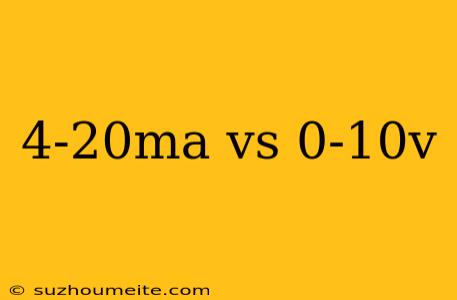4-20mA vs 0-10V: Understanding the Difference
In the world of industrial automation, two popular analog signaling standards are widely used: 4-20mA and 0-10V. Both standards are used to transmit analog signals between devices, but they have distinct differences in terms of functionality, application, and advantages. In this article, we will delve into the details of each standard and explore the benefits of using one over the other.
What is 4-20mA?
The 4-20mA standard is a current-based analog signaling method that uses a 4-20 milliampere current range to represent a 0-100% signal. This standard is widely used in industrial automation applications, particularly in process control systems, where it is often used to transmit signals from sensors and transmitters to control systems and displays.
The 4-20mA standard offers several advantages, including:
- High noise immunity: The current-based signal is less susceptible to electromagnetic interference (EMI) and radio-frequency interference (RFI), making it a reliable choice for industrial applications.
- Long-distance transmission: The 4-20mA signal can be transmitted over long distances without significant degradation, making it suitable for applications where sensors and control systems are located far apart.
- Simple wiring: The 4-20mA standard uses a two-wire connection, which simplifies wiring and reduces installation costs.
What is 0-10V?
The 0-10V standard is a voltage-based analog signaling method that uses a 0-10 volt range to represent a 0-100% signal. This standard is commonly used in industrial automation applications, particularly in applications where high-resolution signals are required.
The 0-10V standard offers several advantages, including:
- Higher resolution: The 0-10V standard can provide higher resolution signals than the 4-20mA standard, making it suitable for applications where precise measurements are required.
- Easy to implement: The 0-10V standard is easy to implement and requires minimal circuitry, making it a cost-effective option.
- Wide range of devices: The 0-10V standard is supported by a wide range of devices, including sensors, transmitters, and control systems.
Key Differences
When deciding between the 4-20mA and 0-10V standards, several key factors should be considered:
- Signal type: The 4-20mA standard uses a current-based signal, while the 0-10V standard uses a voltage-based signal.
- Resolution: The 0-10V standard generally provides higher resolution signals than the 4-20mA standard.
- Noise immunity: The 4-20mA standard is more resistant to electromagnetic interference (EMI) and radio-frequency interference (RFI) than the 0-10V standard.
- Wiring complexity: The 4-20mA standard uses a two-wire connection, while the 0-10V standard typically requires a three-wire connection.
Conclusion
In conclusion, both the 4-20mA and 0-10V standards have their advantages and disadvantages. The 4-20mA standard is a reliable choice for industrial automation applications where noise immunity and long-distance transmission are critical. The 0-10V standard, on the other hand, is suitable for applications where high-resolution signals are required. By understanding the key differences between these two standards, engineers and technicians can make informed decisions when designing and implementing industrial automation systems.
